INTRO: On September 14, 2012, I served as the guest speaker at the grand opening and dedication of the new Structural/ Materials Engineering Building at UC San Diego (UCSD). Present also and offering remarks were Frieder Seible, Dean of the Jacobs School of Engineering; Pradeep Khosla, the new Chancellor of UCSD; Nathan Fletcher, State Assemblyman; Seth Lerer, dean of UCSD's Division of Arts and Humanities; and Karl Beucke, President of Weimar's famed Bauhaus University. Also present: Irwin Jacobs, founder of Qualcomm and benefactor of the Jacobs School, Bob Akins, my old office mate in graduate school and a founder of Cymer Corp. A video of my talk is available.
The new building is a marvel. Many afterward asked if I would publish my speech. I hadn't intended to! But fortunately, my notes were easy to transcribe. So here it is.
The New Modernism: Blending science, engineering, art, and human imagination
Deans Seible and Lerer ... Chancellor Khosla... Assemblyman Fletcher.. distinguished guests from the Bauhaus, faculty, students and friends. It's a great honor to speak at the dedication of the latest wonder here at UC San Diego. The mammoth and magnificent Structural&Materials Engineering Building whose every trait and design feature should help unleash the creativity of those who work within.
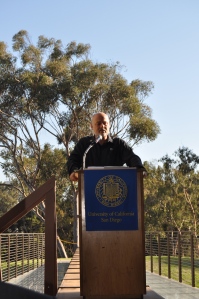 Built by the people of this state, with help from generous donors, it represents a major investment in the future of the University of California system, a system which I deem to be one of the diadems in the crown of human civilization.
Built by the people of this state, with help from generous donors, it represents a major investment in the future of the University of California system, a system which I deem to be one of the diadems in the crown of human civilization.
Here you'll find the new home for endeavors ranging from the ultra-small up to macro and even mega scales. Problem-solvers within these walls will send robots into the bloodstream and mysterious, non-linear realms within the cell. New work in fluidics, materials and battery storage systems will help us tackle vexing energy problems, extending efficient sufficiency to many of the world's rising poor and helping sustain a planet-wide middle class.
Here, researchers will test the stability of the Earth and strengthen the structures that we plant upon it. They'll innovate and improve the vehicles that carry us across and under the seas, or into the sky and space.
The composites that make up our vehicles, aircraft and sporting equipment will grow stronger and lighter, and save vast amounts of energy while making us safer. Some will be capable of activity, flexing like muscle or re-shaping themselves, on command. They might also serve as substrates for embedded computational elements, so that the phrase "smart materials" will take on new meaning.
It will be an amazing world when your shoes, your shirt and your dinner plate all actively compute according to your stated desires, responding to your will, learning to serve you with the same graceful assurance that you now expect, when you command the fingers of your hand
And yet another group will operate within these fascinating walls. The Medical Devices department will continue UCSD's tradition of finding ways to overcome illness, debilitating handicaps and even some of the limitations placed on us by evolution.
 But I want to remark on another milestone. It is fifty years since the great philosopher C.P. Snow gave his famous address lamenting how the academic world had divided into "two cultures" - one scientific and the other consisting of the arts, the humanities and so on.
But I want to remark on another milestone. It is fifty years since the great philosopher C.P. Snow gave his famous address lamenting how the academic world had divided into "two cultures" - one scientific and the other consisting of the arts, the humanities and so on.
Both realms attract great minds! Yet, Snow appraised how these worlds of discourse appeared to speak different languages, parse different logics and view reality in fundamentally incompatible ways.
Academic "scholarship" in the humanities and arts seemed to view Truth with a rear-view mirror of citation, reputation and precedence, in a tradition going back millennia.
Science took a very different approach, in which fame or reputation could be trumped or overcome by fresh facts. In this new culture, every assertion was viewed as contingent, requiring perpetual re-evaluation through criticism and scrutiny by the next experiment. Then the next.
And yet, this contingency did not led to murky chaos, but to ever-rising confidence in an ever-growing model of the world.
Science distrusted the squishiness of subjective intuition or reasoning. In return, those who dwelled across campus saw scientists as "boffins" obsessed with merely solid things, bereft of vision or soul.
Underlying this divide was the noxious notion that limited so many of our ancestors... the Zero Sum Game... the assumption that you cannot achieve new powers without abandoning or losing something else. Perhaps something precious. And make no mistake, this way of thinking dominated nearly all human cultures, leading to the banal and stifling logic of feudalism.
One might even envision the great Enlightenment Project -- with its creative markets, science, democracy and so on -- as boiling down to one thing, a rebellion against Zero Sum thinking. A two century campaign to become more than just the sum of our small victories and individual defeats.
Snow despaired over these two cultures ever crossing their divide, though he hoped that it would happen somehow... someday...
...and behold! Look around you now. It is here, at UCSD... situated in the "bottom left corner of the continent," where anything loose can roll into a wondrous pile... that the dream is coming true, at last. Where members of both academic cultures want it to come true.
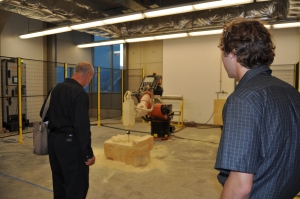 For here, in this marvelous new SME building, fiercely pragmatic researchers and dissectors of objective reality will share floors with the Department of Visual Arts, in spaces that are deliberately intermingled so that engineers will constantly find themselves engaged in conversations with right-brain creators.
For here, in this marvelous new SME building, fiercely pragmatic researchers and dissectors of objective reality will share floors with the Department of Visual Arts, in spaces that are deliberately intermingled so that engineers will constantly find themselves engaged in conversations with right-brain creators.
And our friends from the Bauhaus know what emerges when that happens.
Something called design.
The joyful blending of breakthrough technology with artistic sensibility... extravagant imagination merging with utilitarian vision, leading, it is hoped, to spaces and tools and devices and projects and inventions... as well as wonderful frivolities... that people not only find useful but love to use, amid a growing prosperity that's perfectly compatible with a sustainable Earth.
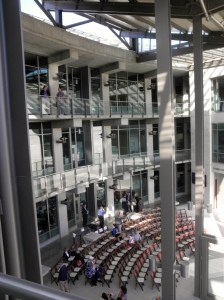 Attention to design becomes clear as you wander this new building. Observe the way that open space is used, taking advantage of views and the spectacular San Diego environment. A paradise, indeed! Though one that is also a desert, with little water or energy to spare, And so the design strives hard to compensate with breakthrough efforts at efficiency.
Attention to design becomes clear as you wander this new building. Observe the way that open space is used, taking advantage of views and the spectacular San Diego environment. A paradise, indeed! Though one that is also a desert, with little water or energy to spare, And so the design strives hard to compensate with breakthrough efforts at efficiency.
Within, you'll find the groups and departments arranged in clusters that gather professors near their students around common collaborative areas... then other commons areas attract interactions between departments and groups.
And as Dean Lerer alluded in his remarks about building bridges, SME is well situated to stimulate the rest of the campus, encouraging ideas to infiltrate outward, and within.
 This building will thrive because its "cells" are leaky. Its structure is malleable and adaptable to changing needs, deliberately almost biological.
This building will thrive because its "cells" are leaky. Its structure is malleable and adaptable to changing needs, deliberately almost biological.
Not a rigid expression of one architect's ego, but a willing servant to many more generations of pioneers, who will work within these walls. And who will want to move some of the walls, to make this structure truly theirs.
That is they way design will have to be in the future.
And speaking of the future, the SME has not left out foresight, the gift that springs, as if from the prefrontal lamps of our brows shining light on the perils and opportunities ahead.
Two institutions dedicated to foresight will have their homes here:
The Center for Design and Geopolitics
and
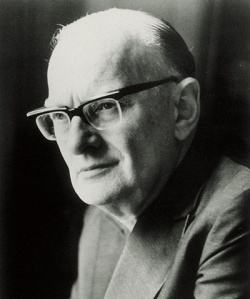 The Arthur C. Clarke Center for Human Imagination.
The Arthur C. Clarke Center for Human Imagination.
It happens that I had a humble role in helping Professors Sheldon Brown and David Kirsh plan this bold venture with the Clarke Foundation and every single dean at UCSD, along with the heads of the Salk and Neuroscience Institutes and many other partners, aiming to bring to bear all the tools of science and the arts toward plumbing a great mystery -- where does the fantastic gift of imagination come from?
How can it be taught and nurtured? Can we simultaneously unleash imagination with greater freedom, yet better harness it to individual and human needs?
This cross fertilizing goal of the Arthur Clarke Center is a fitting tribute to Arthur's life, as both a scientist and vividly prescient storyteller... and one who was my personal role model. I'm proud that my alma mater is honoring him with this bold endeavor.
May I mention a pertinent point? More successful science fiction authors have emerged from UCSD than any other campus on Earth, prompting one of your predecessors, Chancellor Khosla, to ask "Is there something in the water?"
No, it is in the air. In the ambiance. In the attitude of a civilization, a state, a county, a campus... a building... that views prim scholarly categories as mere suggestions.
A place where the core emphasis remains on our scientific projects... using new structures and new materials to augment our tools, aircraft, buildings, and even our lives...
... but where that process benefits and derives much from openmindedness, curiosity, even humor and art.
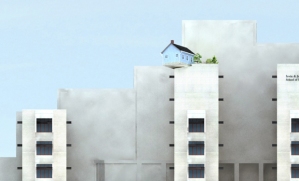 A place where collaboration, innovation, and flow between cultures is not only allowed, but encouraged.
A place where collaboration, innovation, and flow between cultures is not only allowed, but encouraged.
Even better, it is taken for granted. A palace for the Positive Sum Game... the notion that we are not bound by limiting assumptions. Where students and faculty and regular folks feel empowered to say: "I can always be a little more than I am."
It is the theme of a new culture that some find frightening in its hubris. One that is so brash and confident that it takes up the challenge we were thrown long ago, wandering in confusion amid the rubble of that Tower in Babel...
...a challenge to grow mature, to overcome the barriers of misunderstanding that separate us, combining both science and art with wisdom to re-gather in a polyglot world. To decipher the universe. To love and understand it and become its co-creators.
And this is only the beginning of what we will do. Until, truly, as was once promised, we find that nothing is beyond us.



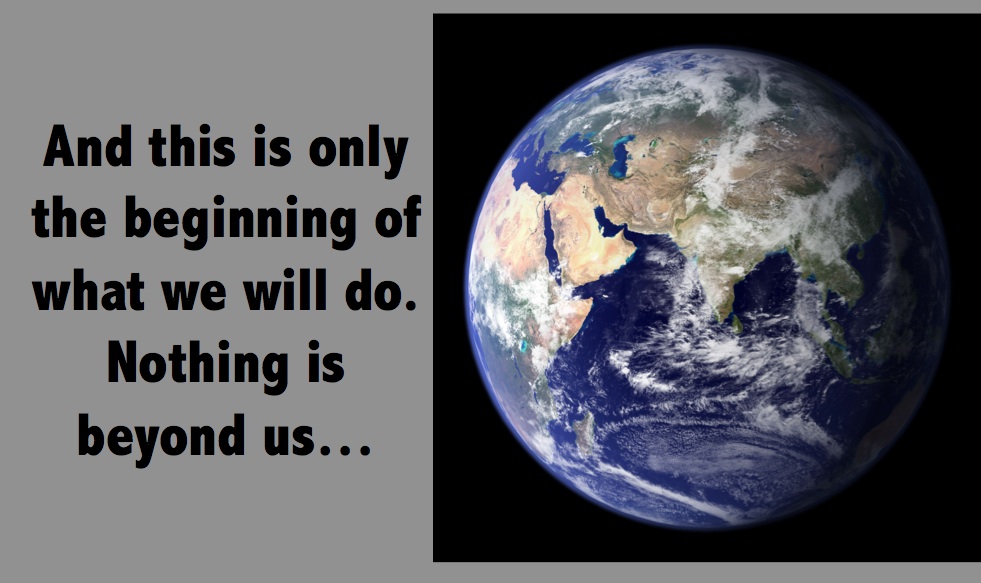

Comments